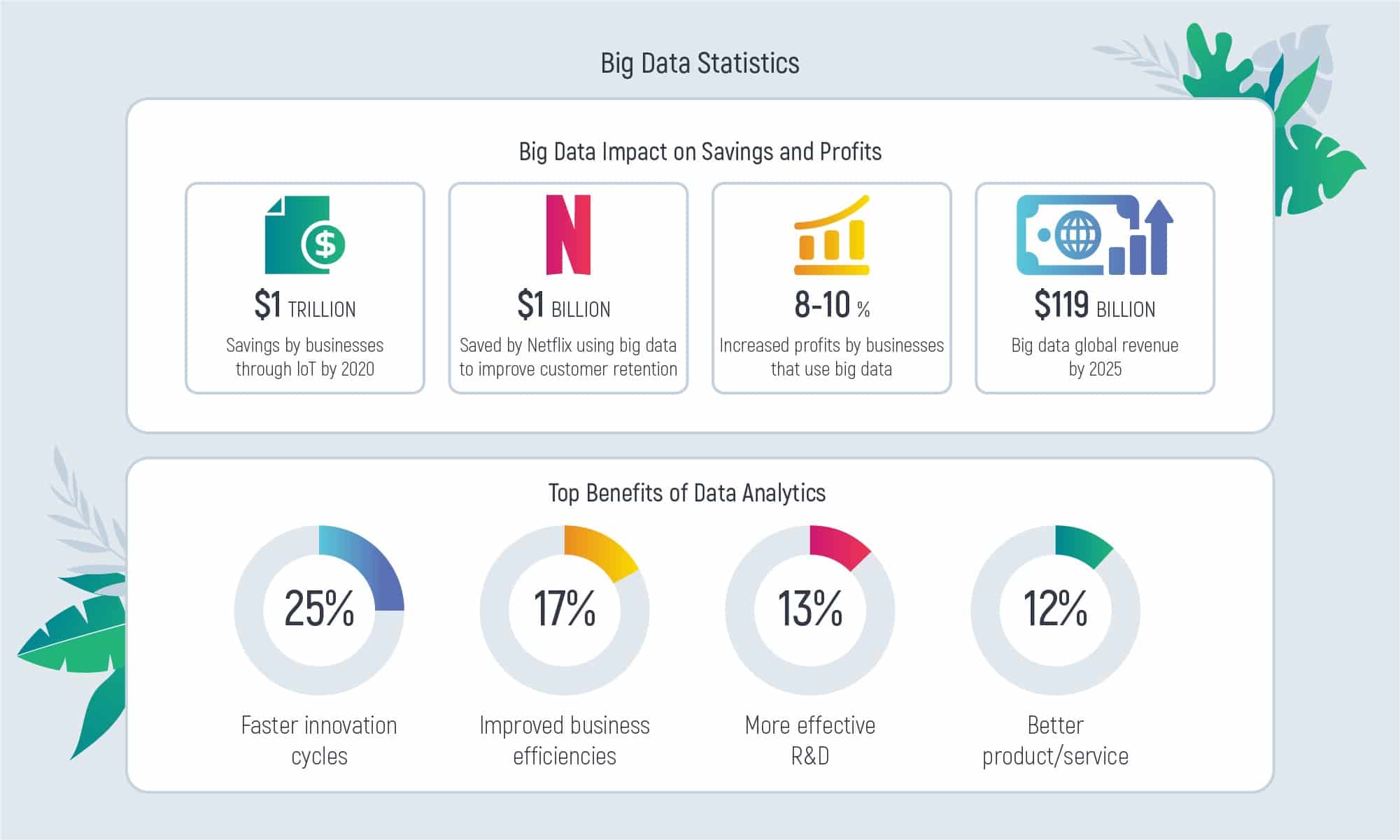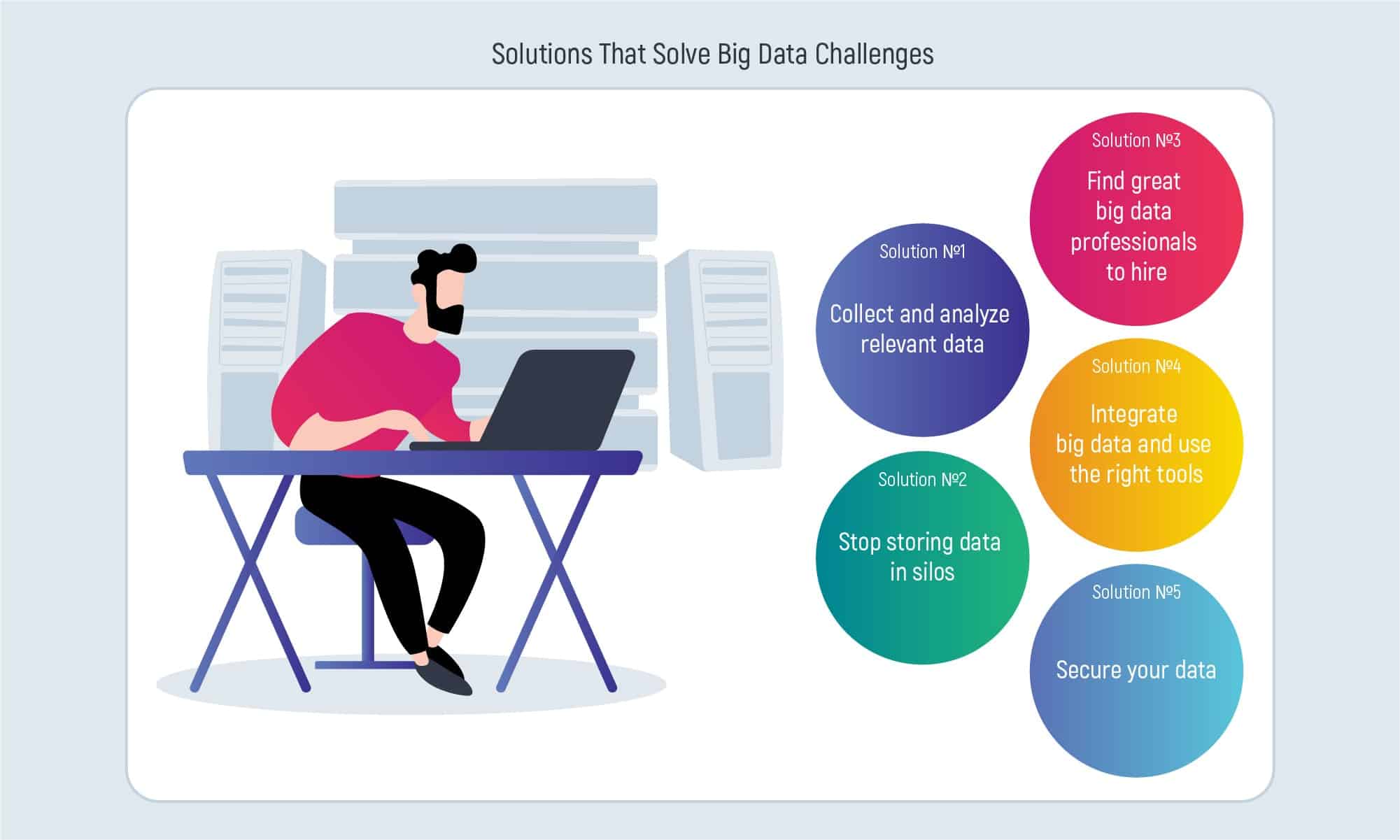Unlock the potential of Big Data by understanding and overcoming its major challenges. In a world producing over 180 zettabytes of data by 2025, harnessing its power is critical. Discover why Big Data is a game-changer, enabling cost savings, increased profits, and improved business processes.
Learn how to collect accurate data, break down silos, secure information, and find the right expertise. Elevate your understanding of Big Data for strategic decision-making and business growth.
What You Will Learn:
- The transformative impact of Big Data on cost savings, profitability, and business processes.
- The significance of the four V"s (Volume, Velocity, Variety, Veracity) in defining Big Data.
- Common challenges faced in Big Data analytics, such as inaccurate and outdated data collection.
- The importance of breaking down data silos for enhanced collaboration and efficiency.
- Strategies to secure data repositories and prioritize cybersecurity in Big Data operations.
- 5 Common Big Data Challenges
- 1. You're collecting inaccurate and outdated data
- 2. Your data is stored in silos
- 3. You’re experiencing a lack of expertise
- 4. You don’t know how to integrate big data and choose big data tools
- 5. You can’t find a perfect solution to secure your obtained data
- How should You Solve Big Data Challenges?
- Solution #1. Collect and analyze relevant data
- Solution #2. Stop storing data in silos
- Solution #3. Find great big data professionals to hire
- Solution #4. Integrate big data and use the right tools
- Solution #5. Secure your data
- Consider Inoxoft Your Trusted Partner
- Final Thoughts
Big Data has been considered one of the breakthroughs of the century. Why? Because the world manages to make use of the data that it produces. For example, thanks to big data it is possible to:
- save costs and obtain increased profits
- leverage the gathered information up to 85%
- improve business processes
- perform faster, and produce better quality services
That’s due to humanity’s gathering of valuable data, structuring it, performing analyses, and getting direct advantages out of this process. It is predicted that in 2025 the global data produced is to be way more than 180 zettabytes. And, there will be various challenges of big data analysis if the production of data is even faster.
Having such big amounts of data to analyze raises a lot of questions. Especially, when the process of data gathering and analysis is not that simple and requires time. So, what are the challenges of big data we are still to face and overcome?
5 Common Big Data Challenges
Before understanding the main challenges that revolve around big data, let’s define the concept once more. Why do we call it a “concept”? Some experts in the field say, “big data” is a compound buzzword.
Big data is both the large volumes of information produced within years and the tools and technologies that spot data patterns deriving useful information from them.
There are four V’s that best describe big data. These are:
Volume — it’s the amount of data produced up to date globally;
Velocity — it’s the pace at which data is being created (a person creates 1.7 megabytes of data per second);
Variety — it’s mixed data (structured, unstructured, semi-structured) that comes from different sources;
Veracity — it’s a mass volume of big data that is uncertain and unclear to the majority of users.
To make use of big data, humanity processes it and stores it in the cloud. There are several stages the data should pass during its lifecycle:
Based on what it is and what it goes through, what big data challenges are there? Are there any problems in big data analytics that big data experts still have to overcome? Let’s explore!
1. You’re collecting inaccurate and outdated data
There are lots of data produced by many sources. But, the point is that you need to extract the most needed one to achieve the best results. What data is supposed to be accurate? The one that can
- meet your business goals
- be useful in advancing your business
- come from your target audience
And, what kind of data is up-to-date? The one that has been collected recently and not more than a couple of years before. You cannot rely on data sets that were relevant ten years ago. Mainly, because the pace of technological progress is insane. And, because everyday humanity produces tons of newer data that becomes more relevant to be analyzed than the one produced before.
2. Your data is stored in silos
Organizations tend to store data in different formats and places. And, what’s more, this data is available to some departments and not for others. Is it a matter of security? Privacy laws of the company? Or, maybe, non-disclosure agreements and smart data governance? In any case, this is not smart at all. The inability to access data is always a blocker to workers.
3. You’re experiencing a lack of expertise
The demand for data science and big data analytics professionals has been increasing daily. And it has already surpassed the availability of these experts on the market. In 2022, big data is named one of the most wanted skills. So, having skilled data scientists on your team is great! But what do you need to ensure your data scientist is an expert?
- a bachelor’s degree in statistics, math, computer science, or economics
- a tech knowledge in statistics and machine learning, coding languages, databases, and reporting technologies
Also, the results of the data analytics performed will speak about your data science expert more than anything else. With the right person on the team, your business will only grow.
4. You don’t know how to integrate big data and choose big data tools
What concerns data integration, any information you receive is gathered from different sources. But it is important to understand that this data works best for a business when being combined. Despite the fact, the companies lack knowledge or neglect data integration altogether. Having data merged into one is crucial for data-driven analysis, reporting, and business intelligence procedures. It can become your best strategy after all.
What concerns big data technologies is that it is a must to have data analytics tools and data storage. What tools and means should businesses select? Which ones would suit this particular business and which wouldn’t? Tricky questions, indeed. Especially, with the variety of tools on the market. If the company chooses poorly it is likely that it will waste money, time, and developer efforts.
5. You can’t find a perfect solution to secure your obtained data
Security is one of the top priorities in the world these days. Inadequate security management can lead to data loss for millions of records. And this is a serious security breach. Protecting data repositories is crucial to ensure the data is being kept safe. Sometimes, operating with data puts security at the end of the list. But it should be at the top.
How should You Solve Big Data Challenges?
Understanding the challenges there are concerning big data is only half of the success. But, how can you reduce big data challenges? Let’s define a solution for each of these challenges in big data analytics.
Solution #1. Collect and analyze relevant data
To collect relevant data it is best to use AI and ML tools. Here, you will be able to do data purging automation. Clearing your data off the unwanted and unimportant details may be promising as business analysts’ work will be faster and more efficient. Also, it would be wise to hire a good data architect to build effective data analytics processes.
Solution #2. Stop storing data in silos
Silos should be left in the past. Store your data according to a data governance scheme. Establish company policies, procedures, and processes to promote data quality, make it visible and accessible to all, who might need it, and ensure the data is encrypted. This way, your teams will not be blocked by requesting access and finding ways to get the necessary data they need to work with. A business should share critical business data among departments and let them work together and use it together as well. Why is it important? To avoid errors. To make team cooperation more efficient. To promote team communication.
Solution #3. Find great big data professionals to hire
Become an investor in your future business growth. Invest in recruitment practices to hire the best big data candidates on the market. Also, you can start a training program within your company and only for your employees. But that will work only if there is one good and experienced big data expert to share the knowledge. You can always buy courses for your employees using various platforms such as Udemy, Coursera, etc. Another way to succeed here is to purchase AI and ML-driven knowledge analytics solutions.
Solution #4. Integrate big data and use the right tools
To have a full picture and be able to analyze and make reports of big data, it is vital to merge data from different sources. Also, to do so, you might need to use applicable tools. Random, but here are the perfect data integration tools:
- Talend Data Integration
- Centerprise Data Integrator
- Informatica PowerCenter
- Microsoft SQL QlikView
- ArcESB
- IBM InfoSphere
- Xplenty
- CloverDX
Solution #5. Secure your data
Hire a great cybersecurity expert. What do these experts do? They provide data encryption, control of user identity and access, monitor physical security in real-time, and use great big data security tools. Nothing is as challenging as data protection. But it is worth it.
Consider Inoxoft Your Trusted Partner
Inoxoft is a Data Science and Big Data Analytics company with a great solution-building background. We offer data analytics services to help you gain valuable insights from data. Every insight can enhance your business processes. For instance, big data works perfectly with Artificial intelligence and Machine learning technologies. Our team has vast expertise in providing AI and ML services as well. Using these technologies will result in having the most innovative insights and effective solutions on strategic, operational, and tactical levels.
Get to see our newest case studies that show what we can do for our clients in the most detailed way. Download our Big Data and AI Hype whitepaper to get valuable information on big data challenges and solutions. There’s more you can achieve! Contact Inoxoft if you have any questions, or a project to share with us, and receive a free 15-minute consultation with Brad Flaughter, our Big Data Science expert.
Final Thoughts
The article speaks about 5 major big data problems and solutions to overcome them. Bid data happens to be too voluminous to handle at once. It proceeds to accumulate and pile up every day with enormous speed. Experts in data analytics and business intelligence need to find ways to solve issues occurring due to massive data flow. With the new technologies and the right big data tools, anything becomes possible today.
Insights:
-
Big Data as a Transformative Force: Big data has revolutionized industries by enabling businesses to harness vast amounts of information for cost savings, profit maximization, and process optimization. By leveraging advanced analytics, organizations can achieve significant improvements in efficiency, productivity, and service quality.
-
The Four V’s of Big Data: The concept of big data is characterized by four key attributes: volume, velocity, variety, and veracity. These factors highlight the immense scale, speed, diversity, and uncertainty of data generated and collected across various sources, underscoring the complexity of managing and analyzing such datasets.
-
Challenges in Data Accuracy and Relevance: One of the primary challenges in big data analytics is ensuring the accuracy and relevance of the data being collected and analyzed. Outdated or inaccurate data can lead to flawed insights and decision-making. To address this challenge, businesses must prioritize the collection of timely, relevant data that aligns with their strategic objectives.
-
Data Silos and Accessibility Issues: Data silos, where information is stored in isolated systems or departments, present a significant obstacle to effective data utilization. Siloed data restricts access and collaboration, hindering the organization’s ability to derive comprehensive insights. Implementing data governance strategies and breaking down silos can promote data visibility and accessibility across the organization.
-
Skills Gap in Data Science: The increasing demand for data science and analytics professionals has created a skills gap in the industry. Organizations struggle to find qualified experts with the necessary expertise in statistics, machine learning, coding languages, and database management. Investing in recruitment, training programs, and AI-driven knowledge analytics solutions can help address this challenge and build a competent data analytics team.
-
Integration and Tool Selection Dilemma: Integrating data from disparate sources and selecting the right tools for data analysis pose significant challenges for businesses. Data integration is essential for generating comprehensive insights, but it requires compatible tools and technologies. Choosing the appropriate data analytics tools and platforms can be daunting, as organizations must navigate a vast array of options to find the best fit for their specific needs.
-
Data Security Concerns: Data security is paramount in the era of big data, as organizations grapple with the risk of data breaches and cyberattacks. Securing sensitive data repositories and implementing robust cybersecurity measures are essential to safeguarding valuable information assets. Hiring cybersecurity experts and leveraging advanced security tools can help mitigate risks and protect against potential threats.
-
Solutions to Big Data Challenges: Addressing big data challenges requires a multifaceted approach that encompasses data collection, integration, talent acquisition, tool selection, and security. Solutions such as AI and machine learning-driven data purging automation, data governance schemes, recruitment initiatives, and cybersecurity measures can help organizations overcome these obstacles and unlock the full potential of big data analytics.
-
The Role of Trusted Partners: Partnering with experienced data science and analytics companies like Inoxoft can provide organizations with the expertise and resources needed to tackle big data challenges effectively. These partners offer specialized services in data analytics, AI, and ML, enabling businesses to derive valuable insights and develop innovative solutions to drive strategic growth and competitive advantage.
-
Continuous Learning and Improvement: Embracing a culture of continuous learning and improvement is essential for navigating the evolving landscape of big data analytics. Organizations must stay abreast of emerging technologies, best practices, and industry trends to remain competitive and capitalize on the opportunities presented by big data.
In summary, while big data offers immense potential for businesses to gain actionable insights and drive innovation, it also presents significant challenges that require careful navigation and strategic solutions. By addressing these challenges proactively and leveraging the expertise of trusted partners, organizations can harness the power of big data to achieve their business objectives and stay ahead in a data-driven world.
Frequently Asked Questions
How to reduce challenges in big data analytics?
There are different possibilities to do so. But, the article has spoken about the top 5 solutions:
- Collect and analyze relevant data
- Stop storing data in silos
- Find great big data professionals to hire
- Integrate big data and use the right tools
- Secure your data
What are the most frequent problems in the big data?
- Collection of inaccurate and outdated data
- Storage of data in silos
- A lack of expertise
- Wrong integration of big data and poor choice of big data tools
- Security issues













